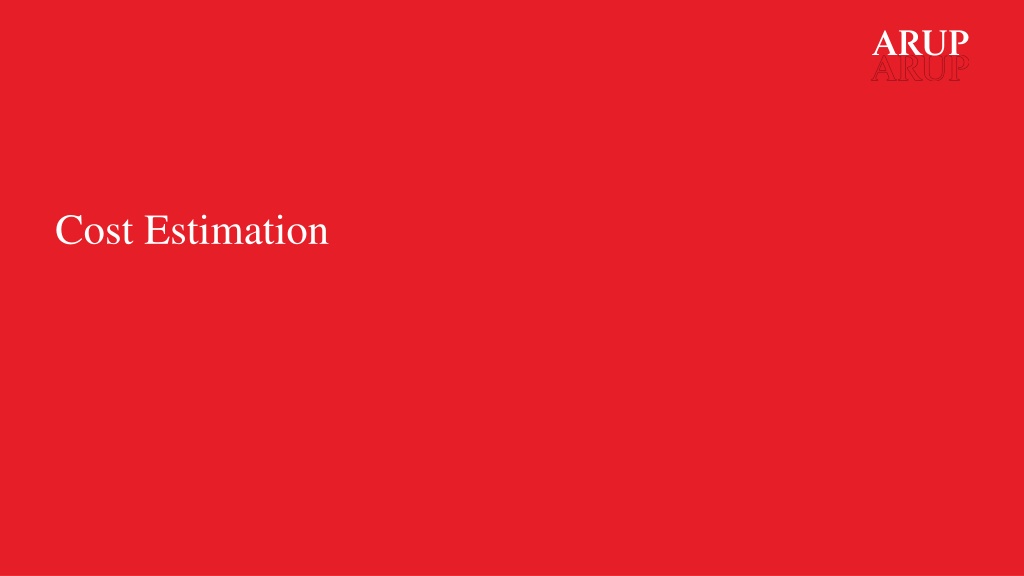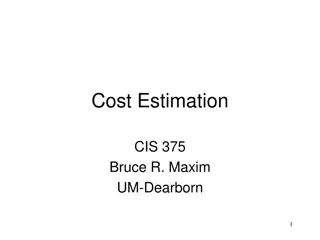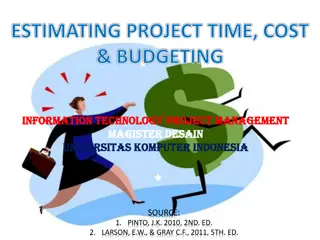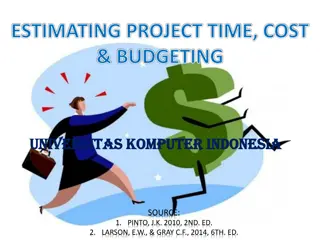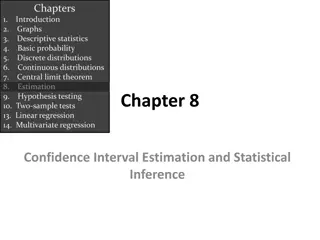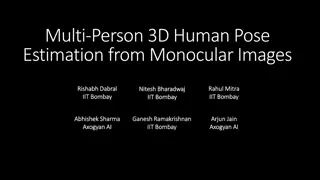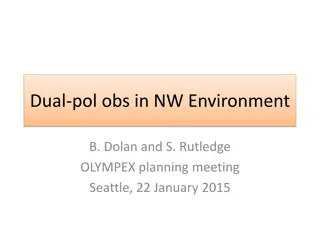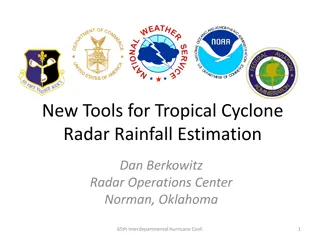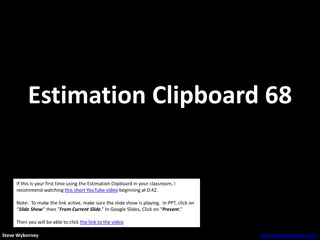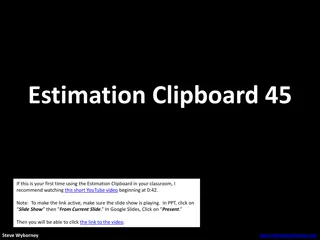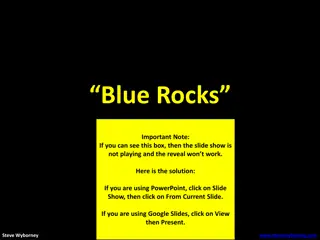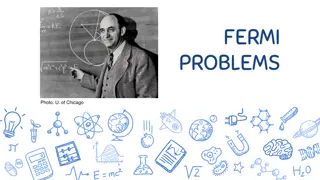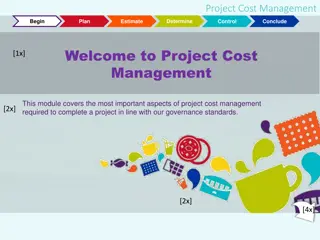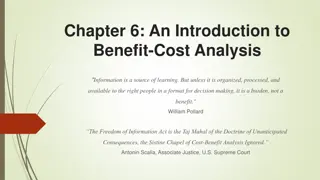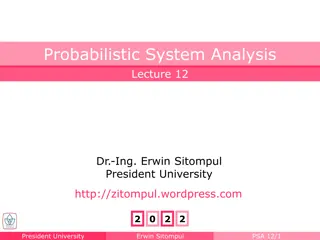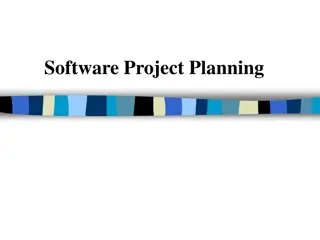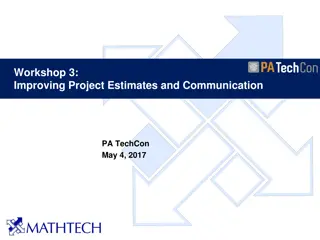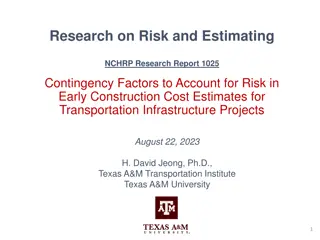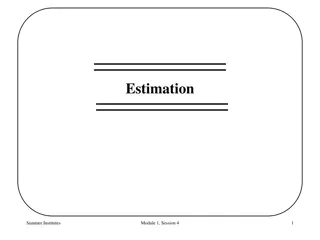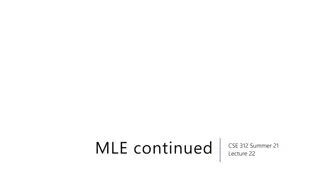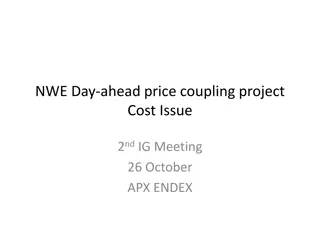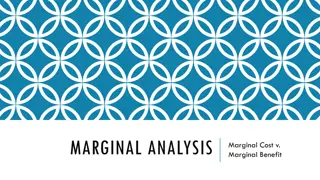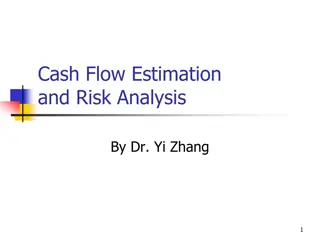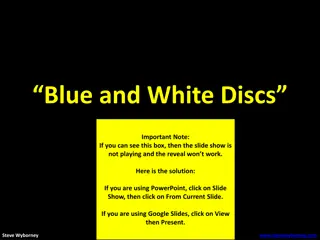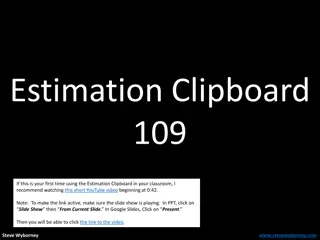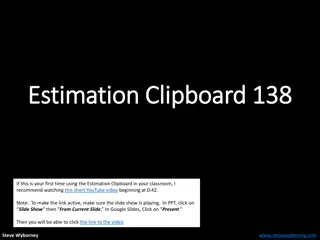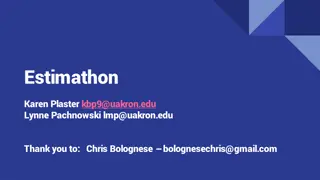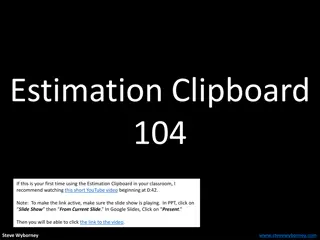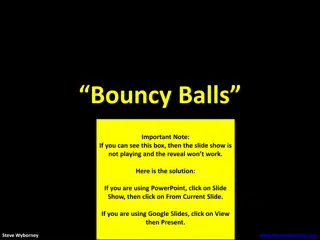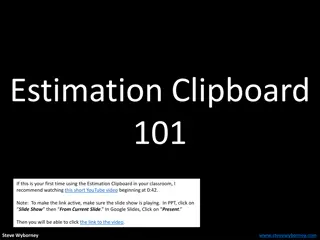Project Cost Estimation Analysis
Conducting a Class 3 estimate during intermediate project stages allows for preliminary budgeting and decision-making. Direct costs cover construction activities, while indirect costs include professional insurance, permits, and contingencies. A breakdown of variances between 90% and 100% project estimates reveals changes in total costs for various scopes and items.
Download Presentation

Please find below an Image/Link to download the presentation.
The content on the website is provided AS IS for your information and personal use only. It may not be sold, licensed, or shared on other websites without obtaining consent from the author. Download presentation by click this link. If you encounter any issues during the download, it is possible that the publisher has removed the file from their server.
E N D
Presentation Transcript
Estimate Classification A Class 3 estimate typically conducted during the intermediate stages of a project when the project scope, design, and specifications have been developed, but some elements may still require further refinement. Class 3 estimates are used for preliminary budgeting, procurement planning, and obtaining more accurate funding approvals. They provide stakeholders with an understanding of project costs and allow for initial decision-making. Based on the level of design and the estimating approach, the accuracy range for the Fermilab TO1 Class 3 Estimate is expected to fall within -15% and +20% of the likely estimate.
Estimate Methodology Direct Costs Direct Costs encompass the expenditures directly tied to the physical construction activities and materials required for a project. Direct unit costs include the costs for material, equipment, and labor for each line item. Such costs are obtained from vendors, past projects and data bases such as labor unions and Trimble Trade Service. Labor productivity rates are derived from the Mechanical Contractors Association of America (MCAA) and the National Electrical Contractors Association (NECA). Difficulty factors are included to increase the unit rate for activities which are anticipated to take more resources to complete than if they were completed in ideal conditions. Adverse conditions that result in higher difficulty factors include: Small, confined working spaces Remote locations for materials laydown that is over several hundred feet away from the final install location Items where additional safety logistics will be required Constrained areas due to existing conditions It is assumed that the general contractor will subcontract the majority of the work. Long lead procurement items (Category B) will be purchased by the owner directly and stored by the general contractor and installed by the appropriate subcontractor per the construction schedule. The general contractor will be responsible for procuring and administering jobsite general requirements such as temporary utilities, job site trailers, temporary cranes, construction material hoists, overflow waste, etc. No allowance has been made for special safety measures related to radiological or hazardous materials safety at the construction site.
Estimate Methodology Indirect Costs Below the Line (BTL) costs encompass the expenses necessary to facilitate and support the construction activities and overall management of a project. The following percentage markups have been included in the estimate. Professional & Pollution Insurance (0.15%) Subcontractor & Supply Subcontractor Default Insurance (1.7%) City Permits & Fees (1.05%) Contractor Bond (1.1%) General Requirements (3%) General Contractor (GC) Staffing & Overhead (8%) Contractor Fee (6%) Construction Contingency (10%) Escalation (5% per annum) Gross Receipts Tax (0.63%)
Summary: Variance Breakdown Summary of Variance between 90% PD Estimate (April 2023) & 100% PD Estimate (July 2023) Total Project Cost (90% PD) Total Project Cost (100% PD) Variance ($) Variance (%) CAT Scope A Building / Sitework $64,522,635 $65,460,724 +$938,089 +1.45% B $34,177,254 $19,238,283 -$14,938,971 -43.71% Long Lead Procured Items C Site Preparation $4,146,338 $4,146,338 $0 0% Direct Buried Chilled Water Feeders D N/A N/A $0 0% E Tunnel Pipework Replacement $471,034 N/A -$471,034 -100% Total Base Scope $103,317,260 $88,845,346 -$14,471,915 -14.01% Alternate Electrical & Plumbing Scope A ALT $607,545 $607,545 $0 0% Tunnel Pipework Replacement Alternate Scope E ALT N/A N/A $0 0% Total w/ Alternatives $103,924,806 $89,452,891 -$14,471,915 -13.93% - Risk-Based Contingency $4,094,277 $3,556,385 -$537,992 -13.14% Total w/ Risk-Based Contingency $108,019,083 $93,009,176 -$15,009,907 -13.90% Note: Values presented in the table above are total project costs (includes direct costs + indirect costs).
Summary: Variance Breakdown Summary of Variance between 90% PD Estimate (April 2023) & 100% PD Estimate (July 2023) Description 90% PD Estimate (April 2023) 100% PD Estimate (July 2023) Variance Direct Cost Indirect Cost Risk-Based Contingency Total $71,064,705 $32,860,101 $4,094,277 $108,019,083 $59,747,965 $29,704,926 $3,556,285 $93,009,176 -15.92% -9.60% -13.14% -13.90% Justification for Variation: Variance is driven by the changes to the direct costs. Several scope items were removed or reduced in order to gain cost savings (see next slide). Changes to indirect costs & risk-based contingency are driven by the direct cost updates.
Direct Cost Summary Summary of Variance between 90% PD Estimate (April 2023) & 100% PD Estimate (July 2023) $71,064,705 Item # Description Value Reduction of Equipment Systems Updates to Equipment Electrical Updates to Site Electrical for Utilities Switchboard / Switchgear Eliminated ($6,144,863) 1 ($2,379,835) 2 ($1,431,285) 3 ($1,140,095) 4 Tunnel Pipework Eliminated ($298,669) 5 Adjustments to Site Prep / Site Improvements $146,301 6 Fire Protection Updates ($40,665) 7 $59,747,965 Structural Columns Updated ($34,417) 8 Updates to Plumbing Systems ($25,533) 9 Adjustments to Site Utilities $17,001 10 $0 Demo & Replacement of LCW Exp. Joints Added $15,320 11 Note: Values presented in the above are direct costs only.
Construction Schedule The work will be completed by a General Contractor with an anticipated start date of April 29, 2026, and ending on October 15, 2029 (a total 860 construction working days). The construction activities end on September 12, 2029 and there is an allowance for one month of float and closeout time. The exception to this schedule is Category B (Long Lead Procured Items) which will commence and be completed earlier. Commissioning services will extend beyond the completion date to 12/24/2029. It is assumed that all subcontractors will have uninhibited, continuous access to the site to for workers vehicles and construction laydown areas in close proximity to the project site.
Construction Funding Profile Fermilab UIP TO1: Preliminary Design of CUB/CWP Construction Funding Curve $100,000,000.00 $93,009,175.67 Total Project $90,000,000.00 $80,000,000.00 $56,744,352.61 Category A (Shell) $70,000,000.00 $60,000,000.00 $50,000,000.00 $20,003,119.71 Category B (Long Lead Items) $24,314,299.45 Category C (Site Prep) $40,000,000.00 $30,000,000.00 $20,000,000.00 $10,000,000.00 $- Jun-23 Aug-23 Jun-24 Aug-24 Jun-25 Aug-25 Jun-26 Aug-26 Jun-27 Aug-27 Jun-28 Aug-28 Jun-29 Aug-29 Oct-23 Oct-24 Oct-25 Oct-26 Oct-27 Oct-28 Oct-29 Apr-23 Apr-24 Apr-25 Apr-26 Apr-27 Apr-28 Apr-29 Feb-24 Feb-25 Feb-26 Feb-27 Feb-28 Feb-29 Dec-23 Dec-24 Dec-25 Dec-26 Dec-27 Dec-28 The first jump is for full funding for the Category B (Long Lead Items) in April 2024 in order to purchase all items at that time to maintain delivery schedule of these items. The second jump is for full funding of the Category C (Site Work) package at the construction start date of April 29, 2026. The third jump is for funding approximately half of the project construction budget for all activities scheduled between March 2027 and November 2027. The final jump is for the remainder of the project construction budget for all activities between November 2027 and the final completion date of October 15, 2029.
Risk-Based Contingency The risk register has been developed using project information gathered through discussions with the project team members. Risk # Risk Category Description Financial and Schedule Risk existing valves do not hold 40 42 Experiencing longer than quoted lead/wait times on products and equipment due to supply chain issues. Financial and Schedule Constructability Risk of dewatering failure 38 The risk register includes an assignment of probability and impact for each identified risk. An impact consists of both a capital cost should the risk trigger, as well as an associated schedule impact. Vibration from construction impacts on existing beam line and tunnel 43 Operations Constructability Risk that earth embankment structure fails 18 12 Lack of adequate laydown areas in proximity to the site allowing for piping to be assembled. Constructability 19 Constructability Unforeseen ground conditions during construction The capital cost impacts are based on direct costs only. The cost value of a schedule delay was determined by developing a daily schedule burn rate by attributing the sum of indirect and overhead costs to the total number of construction schedule days. Constructability Damage to existing tunnel during excavation 28 Constructability Exceeding radiation limits during construction 31 Underpinning existing structure due to 5' trenching required for new sanitary line 39 Constructability 25 Constructability Damage of existing utility lines during construction 35 Risk that minimum operational requirements of existing mechanical & electrical equipment cannot be maintained during construction Constructability Accidental damage to existing chemical treatment material currently on site 34 Constructability
Risk-Based Contingency Quantitative Risk Analysis (QRA) was run on the individual risk register line items to simulate the Risk- Based Contingency. The QRA is a Monte Carlo simulation with 10,000 iterations on the probability and impact of each risk triggering. Probability Density Function with Cumulative Distribution Tornado Chart
Risk-Based Contingency The P80 confidence level has been utilized for the Risk-Based Contingency value in the Class 3 Estimate. Subtotal Risk-Based Contingency Value ($) Risk-Based Contingency Percent (%) Confidence Level Construction Value ($) P50 $89,452,891 $1,784,352 2.0% $89,452,891 $3,556,285 4.0% P80
